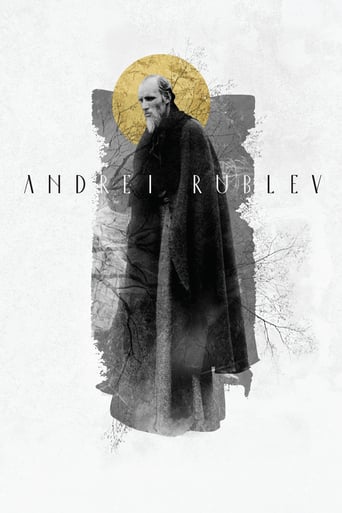
For historical epics to mean anything to me, they must reflect the actual period that they represent. The films that succeed in opening this window into time will transport me into a foreign world that no longer exists. Most of these films follow a plot of interesting characters during turbulent times. Andrei Tarkovsky’s, historical epic, “Andrei Rublev”, discards the need for an actual plot to concentrate on opening this window into 15th century Russia.
15th century Russia was a violent world suffering from constant War, either civil or against the invading Tatars. This was the world that the real Rublev lived in. Rublev was one of the greatest medieval Russian painters of Orthodox Christian icons and frescos. Other than the film’s epilogue Tarkovsky does not depict the creation of any of Rublev’s works of art in his film. What he does depict is the harsh cruel world that would serve as the artists inspiration. The epilogue is the only part of the movie in color and shows details of several of Andrei Rublev’s actual surviving icons. The rest of the movie is filmed in striking black and white, which I felt was a fitting depiction to the cold, harsh, and cruel world shown.
At over three hours long, the movie, along with an Epilogue and prologue, is divided into eight chapters. Each chapter involves the psychological development of Rublev in becoming the artist that he was. From the first chapter titled the Jester we see Rublev as a silent observer of discontent as the Jester criticizes the countries rulers, to other chapters that deal in religion (chapter III. Passion), paganism, which some say is meant to represent the Soviets (chapter IV. The Holiday), oppression (Chapter VI. The last Judgement), as well as the horrors of war (chapter VI. The Raid), to name a few of the chapters.
Of all the chapters in the movie, my favorite is the final chapter titled, “The Bell”. In this chapter the young son of an expert bellmaker who has died of the plague, is tasked with casting a large bronze bell for a church, on behalf of the local prince. The young man claims to be the only one who knows his father’s secret on how to cast such a large bell. In Russian culture bell ringing is one of the most essential elements of the Orthodox church, as the bells are rung to summon the faithful to services, express the triumphal joy of the church, proclaim important events and even strengthen the piety and faith of the people through the sound of the bell. Initially the Prince’s men do not believe the man’s proclamation as to knowing the secret, but eventually relent, allowing him to take charge of casting the bell, under a threat of death if he fails. The construction of such a large bell in the Middle Ages is no small task and Tarkovsky fills his movie with detail during the construction. The young man chooses the location of a large pit, selects the proper clay to be used, overseas the building of the mold, the firing of the furnaces to harden the construction, and the fascinating hoisting of the large bell once complete. In the Middle Ages there was no engines or fuel of any kind and the project required hundreds of workers. This bellmakers son looks to be no more than 18 years old yet takes command of decisions and processes while exerting dictatorial command over all the workers. The depictions of the work are fascinating and when the bell is finally hosted its ability to function is the deciding factor as to whether the young man lives or dies. I felt a nail-biting riveting sensation as the attempt to make the first ring was made. Throughout this chapter Rublev is just an observer, but what he observes is shown to greatly effect his decision on making his future art.
“Andrei Rublev”, is a movie that grows with every passing minute of its runtime. The camera work is sweeping throughout and there are numerous set piece scenes that jump off the screen. Tarkovsky loves faces and films his characters with numerous closeups that serve to reflect deep emotions such as sadness, obsession, and fear. The perspective shown is usually from far or above giving me the feeling that I was watching this movie as an omnipresent observer. As example there is a shot of the walled city of Vladimir that is being attacked in the chapter titled, “The Raid”. Tarkovsky’s camera here swoops from above like a bird, showing the birds below the camera while high above the city. The camera floats and circles from above and is magical in its feel.
This is not an easy movie to watch as there is almost no happiness or joy shown at all. There are also some strong disturbing violent scenes, such as the torture of a Monk and the cruel execution of an innocent man. Yet, with all the brutality and suffering shown, Rublev is shown to have found inspiration through people’s faith. I felt that this inspiration is what drove him to artistic creative heights.
It needs to be mentioned that in making his movie Tarkovsky killed a horse for one unforgettable scene during the war chapter titled, “The Raid”. This was hard for me to watch but needs to be taken in context as to the time the movie was made when there was less awareness to animal rights.
Tarkovsky succeeds in making his film uplifting with its powerful conclusion. When the epilogue reverts to color, we are shown Rublev’s actual works of art, and I felt I understood what inspired the artist and his work. That is quite an achievement for a motion picture.

